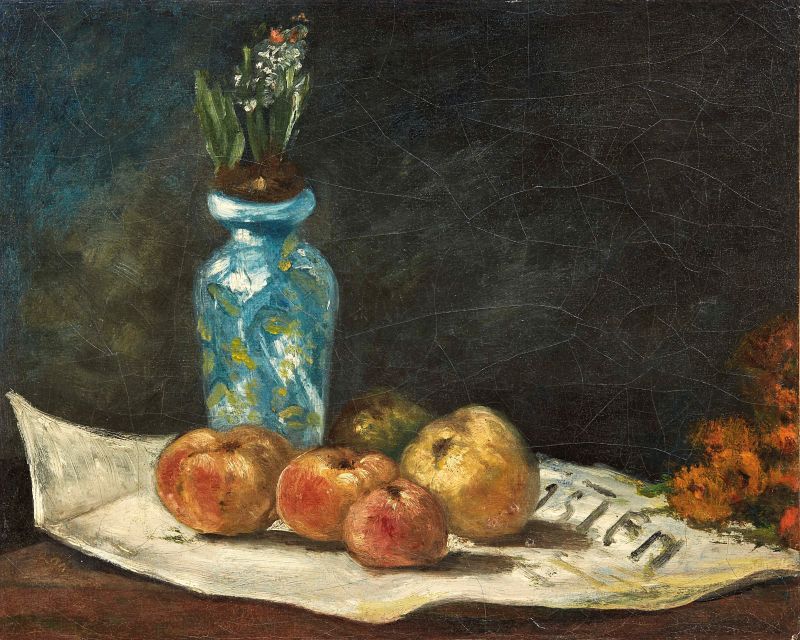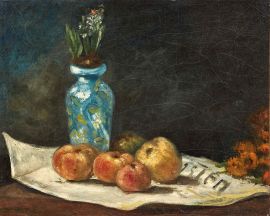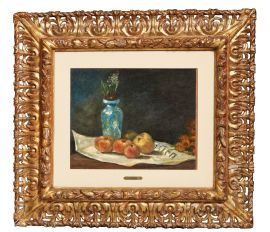Paul Gauguin
(Paris 1848 - Hiva Oa 1903)
JACINTHES ET POMMES SUR UN JOURNAL
1876 circa
firmato in basso a sinistra
olio su tela
cm 33,5x41,6
sul retro: etichetta con “Gauguin 1848-1903 / Silleben” e etichetta con “4926” sul telaio
JACINTHES ET POMMES SUR UN JOURNAL
circa 1876
signed lower left
oil on canvas
13 3/16 by 16 ¼ in
on the reverse: label with “Gauguin 1848-1903 / Silleben” and label with “4926” on the stretcher
L’opera è corredata di attestato di libera circolazione.
An export license is available for this lot.
Provenienza
Collezione Schuffenecker (la foto dell’opera compare nel Fondo Druet-Vizzavona in un lotto di fotografie già di proprieta Jeanne Schuffenecker)
Paris, Petitdidier et Urion
Paris, Galerie Fiquet
London, collezione J.G. Lousada, 1926 circa
London, collezione Anthony B. Lousada
Christie’s, London, Estate of Mrs M.R. Lousada, 8 maggio 1953, lotto 102
Koller, Zurich, Vendita 26, 29-30 novembre 1985, lotto 5165
Champin-Lombrail-Gautier, Enghien-les-Bains, Exceptionnels Tableaux et Sculptures, 23 novembre 1986, lotto 50
Sotheby’s, London, Impressionist and Modern Paintings & Sculpture, Part II, 2 dicembre 1987, lotto 104
Christie’s, New York, Impressionist and Modern Paintings, Drawings and Sculpture, 12 novembre 1992, lotto 105
Esposizioni
List of loans at the opening exhibition of the modern Foreign Gallery, The National Gallery, London, 1926.
Bibliografia
G. Wildenstein, Gauguin. 1. Catalogue, Paris 1964, n. 19 bis.
E. Fezzi, Gauguin. Every painting, New York 1980, vol. I, p. 16, n. 21.
D. Wildenstein, Gauguin. Premier itinéraire d’un sauvage. Catalogue de l’oeuvre peint (1873-1888), Milano 2001, vol. I, pp. 40-41, tav. 41.
Questa natura morta, realizzata nel primo periodo di attività dell’artista, secondo Daniel Wildenstein sarebbe stilisticamente collocabile, a prima vista, tra il 1874 e il 1878. In verità c’è un elemento che ci consente di circoscrivere la sua datazione agli ultimi mesi del 1876. Nell’ottobre di quell’anno, infatti, il deputato radicale Louis Andrieux fonda il quotidiano politico “Le Petit Parisien”, giornale che Gauguin raffigura sotto il vaso di giacinti. La presenza del giornale in casa di Gauguin e la decisione di introdurlo tra i componenti della natura morta dimostrano la ferma volontà dell’artista di divulgare le sue simpatie politiche. In questo periodo, la vita di Gauguin è segnata da diversi cambiamenti. Già conosciuto nell’ambiente artistico parigino come collezionista, ambiente a cui era stato avvicinato dal suo tutore, Gustave Arosa, appassionato raccoglitore d’arte contemporanea, nel 1876 Gauguin debutta come pittore al Salon parigino con Sous-bois à Viroflay (Copenhagen, Ny Carlsberg Glyptotek). A quell’epoca, la sua attività pittorica, cominciata, si crede, non prima del 1873, anno di cui si conoscono le prime opere datate, era testimoniata soprattutto da paesaggi intrisi di verde scuro e marrone come se la terra illuminata da un sole poco potente rimanesse intrisa di acqua. Era stata la figlia di Arosa, pittrice, a dargli i primi insegnamenti in materia, arricchiti dallo studio dei capolavori di arte antica copiati al Louvre in compagnia dell’amico Claude - Emile Schuffenecker, conosciuto sul posto di lavoro, presso il broker Paul Bertin. Ai tempi di questa natura morta, nonostante una famiglia da mantenere - era sposato dal 1873 con la danese Mette e avevano dei figli -, Gauguin lascia l’impiego di agente di cambio, ottenuto nel 1872 grazie all’intercessione di Arosa, e inizia a dipingere con maggiore assiduità e frequenta, assieme ad Emile, l’accademia di scultura di Filippo Colarossi. La nipote di Emile, Jeanne, figlia di Amedee Schuffenecker che, alla scomparsa di Gauguin si occuperà di riordinarne i lavori, riceverà dal padre una fotografia in bianco e nero del nostro dipinto, poi conservata nel fondo parigino dei fotografi d’arte Druet - Vizzavona. E in bianco e nero il nostro quadro è riprodotto anche nel Catalogue de l’oeuvre peint di Wildenstein pubblicato nel 2001. I colori contribuiscono a far risaltare la plasticità degli elementi disposti su una superficie piana in un interno dallo sfondo scuro. Appoggiate sulla bianca pagina del giornale, fonte preziosa per dare luce alla composizione, alcune mele fanno da contorno a un vaso di giacinti, fiori invernali ripresi nella decorazione dello stesso contenitore. Nella maggior parte dei casi noti finora, le nature morte realizzate negli anni Settanta seguono quasi uno standard: in interni, con fondo neutro, su un piano, in genere un tavolo, con un tovagliolo, un giornale o uno spartito musicale collocati sotto a frutta, fiori, vasi. Fiori e frutta aiutano a capire in che stagione sia stata realizzata l’opera. Non si tratta sempre di opere datate; il primo esempio di natura morta della produzione di Gauguin e Cerises et carafon databile al 1875-77. Nel 1876 Gauguin realizza il dipinto Bouquet de pivoines sur une partition, primo soggetto in cui gioca con un elemento di carta sotto un vaso poi ripreso nel Fleurs dans un vase bleu et partition. Dopo la realizzazione di Jacinthes et pommes sur un journal, le nature morte si arricchiscono di elementi nello sfondo, fino ad ampliarsi in un vero e proprio quadro di figura, come nel caso di L’intérieur, rue Carcel (1881) in cui il pittore si ritrae di spalle, appoggiato al pianoforte, mentre la moglie è intenta a suonare. L’opera, tuttavia, è caratterizzata dall’esplosione di luce in primo piano grazie alla raffigurazione di un vaso di fiori su una chiara tovaglia, mentre il resto della scena, anche se principale, si sviluppa sullo sfondo, tra tonalità più scure.
According to Daniel Wildenstein, at first glance this still-life painted early in Gauguin’s career would be datable between 1874 and 1878. Actually, there is one component that makes it possible to pinpoint the date to the final months of 1876. In October of that year, the radical depute Louis Andrieux founded the political newspaper Le Petit Parisien that we see under the vase of hyacinths. That Gauguin had the newspaper in his home and decided to include it in the painting speaks to his resolve to divulge his political leanings. Gauguin’s life at the time was filled with changes. Already known as a collector in the Parisian artistic circles – a milieu he had been introduced to by his guardian, Gustave Arosa, an enthusiastic collector of contemporary art - Gauguin made his debut as a painter at the 1876 Salon, with Sous-bois a Viroflay (Copenhagen, Ny Carlsberg Glyptotek). In those days, his paintings – and he is believed to have started no earlier than 1873, the year of his first dated works, consisted mainly of landscapes permeated with dark green and brown as if the ground, illuminated by a weak sun, had been soaked with water. It was Arosa’s daughter – herself a painter – who gave Gauguin his first lessons which he furthered by studying early masterpieces that he copied in the Louvre along with his friend, Claude-Émile Schuffenecker whom he had met while working with the stockbroker Paul Bertin. Around the time Gauguin painted this still-life, even though he had a wife – the Danish woman he married in 1873 – and children to support, he left his job as a stockbroker, that he had obtained in 1872 thanks to Arosa and began painting more steadily. With Émile he also attended the Académie Colarossi founded by the sculptor Filippo Colarossi. When Gauguin died, Émile’s niece, Jeanne, who was Amédée Schuffenecker’s daughter, took care of organizing his paintings. At that time, her father gave her a black-and-white photograph of our painting which was then kept in the Paris collection of the art photographers, Druet-Vizzavona. The picture was also reproduced in black-and-white in Wildenstein’s Catalogue de l’oeuvre peint published in 2001. The colours contribute to highlighting the modelling of the items arranged on a flat surface in an interior with a dark background. Set on a white newspaper – a precious source of light for the entire composition, the apples surround the vase of hyacinths, winter flowers that also decorate the container. In most of the paintings we currently know, the still-lifes he painted in the 1870s practically follow a basic pattern: indoors, neutral backgrounds, flat surface – generally a table, with a cloth, a newspaper or musical score under fruits, flowers or a vase. The fruits and flowers offer a clue to the season when the paintings, that are not always dated, were executed. The first example of a still-life in Gauguin’s oeuvre is Cerises et carafon datable to 1875-77. He painted Bouquet de pivoines sur une partition, in 1876 which was the first time he depicted paper under a vase, a device he reprised in Fleurs dans un vase blu et partition. After Jacinthes et pommes sur un journal, he began enriching his still-lifes with background elements to the point that they developed into real genre scenes such as L’interieur, rue Carcel (1881) in which he portrayed himself from the back, leaning against the piano his wife is playing. The vase of flowers set on a light-coloured tablecloth in the foreground illuminates the entire, and essentially dark, primary subject of the scene.






